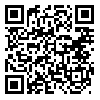جلد 22، شماره 3 - ( پائیز 1404 )
جلد 22 شماره 3 صفحات 205-196 |
برگشت به فهرست نسخه ها
Ethics code: IR.UMSHA.REC.1401.097
Download citation:
BibTeX | RIS | EndNote | Medlars | ProCite | Reference Manager | RefWorks
Send citation to:



BibTeX | RIS | EndNote | Medlars | ProCite | Reference Manager | RefWorks
Send citation to:
Amiri F, Akbari H, Afshari A, salimi R. Patterns of Acute Blood Component Transfusion Reactions in a Hamadan Educational Hospital Inpatients in 3-Years. bloodj 2025; 22 (3) :196-205
URL: http://bloodjournal.ir/article-1-1598-fa.html
URL: http://bloodjournal.ir/article-1-1598-fa.html
امیری فاطمه، اکبری حدیث، افشاری علی، سلیمی رسول. الگوی واکنشهای حاد تزریق فرآوردههای خون در بیماران بستری در یک بیمارستان آموزشی شهر همدان در بازه زمانی سه ساله. فصلنامه پژوهشی خون. 1404; 22 (3) :196-205
دانشیار بیمارستان بعثت ـ دانشکده پزشکی دانشگاه علوم پزشکی همدان
چکیده: (138 مشاهده)
چکیده
سابقه و هدف
واکنش های تزریق خون، واکنش های ناخواسته و اغلب وابسته به پاسخ ایمنی هستند که در فرد گیرنده نسبت به خون و فرآورده های خون تزریق شده بروز می یابد. برخی از این واکنش ها از نوع حاد هستند و ممکن است منجر به بروز علائم شدید و یا حتی مرگ بیمار شوند. شناسایی نوع واکنشهای تزریق خون در کاهش عوارض و مرگ و میر ناشی از آنها اهمیت دارد. هدف مطالعه حاضر تعیین واکنشهای حاد تزریق فرآوردههای خون در بیمارستان بعثت همدان طی سالهای 1398-1400 بود.
مواد و روشها
این مطالعه مقطعی- گذشته نگر بر روی پرونده 428 بیمار بستری که پس از دریافت فرآورده خون واکنش بروز داده بودند در همدان انجام شد. پس از تأیید طرح در کمیته اخلاق، اطلاعات بیماران از سوابق آنها و دفتر هموویژلانس استخراج گردید. نرمافزار SPSS نسخه 24 و با استفاده از آزمونهای آماری تی مستقل و مجذور کای تجزیه و تحلیل گردید.
یافتهها
میانگین سنی بیماران تحت مطالعه 45/33 سال بود. 299 نفر (53/50 درصد) از بیماران مرد و 199 نفر(46/50 درصد) زن بودند. میانگین تعداد فرآورده دریافتی 2/65 بود. 13/10 درصد (56 نفر) بیماران سابقه دریافت فرآورده خون داشتند و 86/90 درصد (372 نفر) فرآورده ای تزریق نکرده بودند. 25/64 درصد فرآورده ها از نوع سلولی و 35/75 درصد از نوع پلاسمایی بود. واکنشهای تبزای غیر همولیتیک تزریق خون (42/15 درصد) و آلرژیک (38/56 درصد) از دیگر واکنشها شایعتر بودند. ارتباط معناداری بین سن بیمار با بروز واکنشهای تبزای غیر همولیتیک تزریق خون (0.020 =p)، آلرژیک (0.019 =p)، افت فشار وابسته به تزریق خون (0.001 =p) و تنگی نفس وابسته به تزریق خون (0.010 =p) وجود داشت. در کل میزان واکنشها به طور معناداری با تعداد واحد فرآورده تزریق شده مرتبط بود (0.030 =p). تزریق فرآوردههای سلولی نسبت به تزریق فرآوردههای پلاسمایی منجر به بروز واکنشهای بیشتری شده بود (0.018 =p).
نتیجه گیری
شایعترین واکنش گزارش شده واکنش تبزای غیر همولیتیک تزریق خون بود. ارتباط معناداری بین سن، تعداد و نوع فرآورده دریافتی با بروز برخی واکنشها وجود داشت. این موارد اهمیت دقت و کنترل بیشتر در درخواست نوع و تعداد فرآورده خون جهت تزریق به بیماران به خصوص افراد مسنتر را گوشزد میکند.
سابقه و هدف
واکنش های تزریق خون، واکنش های ناخواسته و اغلب وابسته به پاسخ ایمنی هستند که در فرد گیرنده نسبت به خون و فرآورده های خون تزریق شده بروز می یابد. برخی از این واکنش ها از نوع حاد هستند و ممکن است منجر به بروز علائم شدید و یا حتی مرگ بیمار شوند. شناسایی نوع واکنشهای تزریق خون در کاهش عوارض و مرگ و میر ناشی از آنها اهمیت دارد. هدف مطالعه حاضر تعیین واکنشهای حاد تزریق فرآوردههای خون در بیمارستان بعثت همدان طی سالهای 1398-1400 بود.
مواد و روشها
این مطالعه مقطعی- گذشته نگر بر روی پرونده 428 بیمار بستری که پس از دریافت فرآورده خون واکنش بروز داده بودند در همدان انجام شد. پس از تأیید طرح در کمیته اخلاق، اطلاعات بیماران از سوابق آنها و دفتر هموویژلانس استخراج گردید. نرمافزار SPSS نسخه 24 و با استفاده از آزمونهای آماری تی مستقل و مجذور کای تجزیه و تحلیل گردید.
یافتهها
میانگین سنی بیماران تحت مطالعه 45/33 سال بود. 299 نفر (53/50 درصد) از بیماران مرد و 199 نفر(46/50 درصد) زن بودند. میانگین تعداد فرآورده دریافتی 2/65 بود. 13/10 درصد (56 نفر) بیماران سابقه دریافت فرآورده خون داشتند و 86/90 درصد (372 نفر) فرآورده ای تزریق نکرده بودند. 25/64 درصد فرآورده ها از نوع سلولی و 35/75 درصد از نوع پلاسمایی بود. واکنشهای تبزای غیر همولیتیک تزریق خون (42/15 درصد) و آلرژیک (38/56 درصد) از دیگر واکنشها شایعتر بودند. ارتباط معناداری بین سن بیمار با بروز واکنشهای تبزای غیر همولیتیک تزریق خون (0.020 =p)، آلرژیک (0.019 =p)، افت فشار وابسته به تزریق خون (0.001 =p) و تنگی نفس وابسته به تزریق خون (0.010 =p) وجود داشت. در کل میزان واکنشها به طور معناداری با تعداد واحد فرآورده تزریق شده مرتبط بود (0.030 =p). تزریق فرآوردههای سلولی نسبت به تزریق فرآوردههای پلاسمایی منجر به بروز واکنشهای بیشتری شده بود (0.018 =p).
نتیجه گیری
شایعترین واکنش گزارش شده واکنش تبزای غیر همولیتیک تزریق خون بود. ارتباط معناداری بین سن، تعداد و نوع فرآورده دریافتی با بروز برخی واکنشها وجود داشت. این موارد اهمیت دقت و کنترل بیشتر در درخواست نوع و تعداد فرآورده خون جهت تزریق به بیماران به خصوص افراد مسنتر را گوشزد میکند.
نوع مطالعه: پژوهشي |
موضوع مقاله:
انتقال خون
فهرست منابع
1. Bansal PN, Raturi M, Singh Ch, Bansal Y. Immunological complications of blood transfusion: current insights and advances. Current Opinion Immunol. 2025; 96: 102617. [DOI:10.1016/j.coi.2025.102617] [PMID]
2. Yazdandoust E, Amini-Kafiabad S. Transfusion-associated graft-versus-host disease: pathophysiology, complications, prevention. Sci J Iran Blood Transfus Organ 2024;21(1): 82-95. [Persian]. [DOI:10.61186/bloodj.21.4.269]
3. Delicou S, Argyrou A, Mellou S, Xydaki A, Gafou A, Politis C. Acute Painful Transfusion Reactions (APTRs): A Comprehensive Review of Clinical Features, Pathophysiology, Diagnosis, and Management. Thalassemia Reports. 2025; 15(1):1. [DOI:10.3390/thalassrep15010001]
4. Rezaei M, Amiri F, Razaghi M, Mohammadi F. Evaluation of blood transfusion-related reactions of blood recipients in Hamadan besat hospital patients during 2020-2022. Avicenna J Care Health Oper Room. 2023; 1(3):94-98. [DOI:10.34172/ajchor.36]
5. Amiri F , Jambozorg H, Biglari M, Mohammadi A, Afshari M, Seyedi SMR. Survey on the blood transfusion-related reactions in blood recipients referred to Hamadan hospitals in 2018-2019. Sci J Iran Blood Transfus Organ. 2021; 18(2): 87-96. [Persian].
6. Frazier SK, Higgins J, Bugajski A, Jones AR, Brown MR. Adverse Reactions to Transfusion of Blood Products and Best Practices for Prevention. Crit Care Nurs Clin North Am. 2017;29(3):271-290. [DOI:10.1016/j.cnc.2017.04.002]
7. Soutar R, McSporran W, Tomlinson T, Booth C, Grey S. Guideline on the investigation and management of acute transfusion reactions. Br J Haematol. 2023;201(5):832-844. [DOI:10.1111/bjh.18789] [PMID]
8. Kumar R, Gupta M, Gupta V. Acute transfusion reactions (ATRs) in intensive care unit (ICU): a retrospective study. J Clin Diagn Res 2014;8(2):127-9
9. Sovic D, Dodig J. Transfusion treatment at Sestre Milosrdnice University Hospital Center during a twelve-year period. Acta Clin Croat 2015;53(3):342-7.
10. Dasararaju R, Marques MB. Adverse effects of transfusion. Cancer Control. 2015; 22(1):16-25. [DOI:10.1177/107327481502200104] [PMID]
11. Rajesh K, Harsh S, Amarjit K. Effects of prestorage leukoreduction on the rate of febrile nonhemolytic transfusion reactions to red blood cells in a tertiary care hospital. Ann Med Health Sci Res 2015;5(3):185-8 [DOI:10.4103/2141-9248.157498] [PMID] []
12. Frazier SK, Higgins J, Bugajski A, Jones AR, Brown MR. Adverse Reactions to Transfusion Blood Products and Best Practices for Prevention. Crit Care Nurs Clin North Am. 2017;29(3):271-290. [DOI:10.1016/j.cnc.2017.04.002]
13. Ning S, Solh Z, Arnold DM, Morin PA. Premedication for the prevention of nonhemolytic transfusion reactions: a systematic review and meta-analysis. Transfusion. 2019; 59(12):3609-3616. [DOI:10.1111/trf.15566] [PMID]
14. Birchall J, Tinegate H, Regan F. On behalf of the Serious Hazards of transfusion (SHOT) Steering Group. The 2014 Annual SHOT Report; 2015
15. SHOT bite No5.Febrile allergic and hypotensive transfusion reactions (FAHR). Serious Hazards of transfusion (SHOT) Steering Group. 2018.
16. SHOT bite No10. Acute Transfusion Reactions (ATR). Serious Hazards of transfusion (SHOT) Steering Group. 2019.
17. Mohammadi A, Shafagh E, Kambizi S, Report of blood transfusion reaction related to human error in two thallassemia patiens. Hospital J. 2013; 14: 32-35 [Persian].
18. Bodaghkhan F, Ramzi M, Vazirian S, Ahmadi M, Hajebi Rajabi M, Kohan N, et al. The prevalence of acute blood transfusion reactions in Nemazee Hospital. Sci J Iran Blood Transfus Organ. 2014;11(3):247-51. [Persian].
19. Grandi J and colleages, describe the occurrence of immediate transfusion reactions received by the Risk Management Department of Hospital São Paulo, Sci Elec LibOnline. 2018,52:1-7.
20. Priya S, V K, Srinivasan S. Retrospective Audit of Transfusion Reactions in a Tertiary-Care Hospital in South India. Cureus. 2024;16(12):e74930. [DOI:10.7759/cureus.74930]
21. Gupta S, Kumar R, Kakkar S. Incidence and Pattern of Transfusion Reactions and its Association with Blood and its Components in a Tertiary Care Hospital. J Assoc Physicians India. 2025;73(8):35-39. [DOI:10.59556/japi.73.1081] [PMID]
22. Tadasa E, Adissu W, Bekele M, Arega G, Gedefaw L. Incidence of acute transfusion reactions and associated factors among adult blood-transfused patients at Jimma University Medical Center, southwest Ethiopia: A cross-sectional study. Medicine (Baltimore). 2024;103(32):e39137. [DOI:10.1097/MD.0000000000039137] [PMID] []
23. S Yune, K O'Brien, Transfusion reaction patterns by blood component. Am J Clin Path. 2024; 162 (1): 147-156. [DOI:10.1093/ajcp/aqae129.327]
24. Sharma DK, Datta S, Gupta A. Study of acute transfusion reactions in a teaching hospital of Sikkim: A hemovigilance initiative. Indian J Pharmacol. 2015;47(4):370-4. [DOI:10.4103/0253-7613.161257]
25. Kato H, Nakayama T, Uruma M, Okuyama Y,Handa M, Tomiyama Y, et al. A retrospective observational study to assess adverse transfusion reactions of patients with and without prior transfusion history. Vox San.2015;108(3): 243-250. [DOI:10.1111/vox.12208] [PMID]
26. Muche Y, Gelaw Y, Atnaf A, Getaneh Z. Blood Transfusion Complications and Associated Factors Among Blood-Transfused Adult Patients at Debre Markos Comprehensive Specialized Hospital, Ethiopia: A Cross Sectional Study. J Blood Med. 2023; 15: 389-98. [DOI:10.2147/JBM.S412002] []
27. Mirsadeghi M, Ghazanfar TehranS, Hamidi Madani Z ,Habibi MR , Ahmadi M , Toghtamesh M, et al. Investigation of the Frequency of Reactions and Consequences of Blood Transfusion in an Academic Center Guilan-Iran.Zahedan J Res Med Sci. 2024; 26(3): e145821. [DOI:10.5812/zjrms-145821]
28. Kasim J, Aldarweesh F, Connor JP. Blood product and laboratory resource wastage in non-severe allergic transfusion reactions: an opportunity for improvement. Transfus Med. 2019;29(5):338-343. [DOI:10.1111/tme.12630] [PMID]
29. Tinmouth A. Reducing the amount of blood transfused by changing clinicians' transfusion practices. Transfusion. 2007;47(2 Suppl):132-5.2013;5(3):148-57. [DOI:10.1111/j.1537-2995.2007.01369.x]
30. Vejdani M. Prospective risk assessment of blood transfusion in Pediatric Emergency Department of Ghaem Hospital by the Health Failure Mode and Effects Analysis methodology. Sci J Iran Blood Transfus Organ. 2015; 11(4): 325-336. [Persian].
31. Ashvandi D, Bakhshi M, Azizi E. Survey on blood transfusion reactions in thalassemia patiens reffered to educational hospital of Hamadan. Sci J Hamadan nursing midwifery. 2009; 17(12): 53-63 [Persian].
32. Refaai MA, Blumberg N. The transfusion dilemma--weighing the known and newly proposed risks of blood transfusions against the uncertain benefits. Best Pract Res Clin Anaesthesiol. 2013; 27(1):17-35. [DOI:10.1016/j.bpa.2012.12.006] [PMID]
33. Timler D, Klepaczka J, Kasielska-Trojan A, Bogusiak K. Analysis of complications after blood components' transfusions. Pol Przegl Chir. 2015;87(4):166-73. [DOI:10.1515/pjs-2015-0039] [PMID]
34. Ackfeld T, Schmutz T, Guechi Y, Le Terrier C. Blood Transfusion Reactions-A Comprehensive Review of the Literature including a Swiss Perspective. J Clin Med. 2022;11(10):2859. [DOI:10.3390/jcm11102859] [PMID] []
ارسال پیام به نویسنده مسئول
| بازنشر اطلاعات | |
 |
این مقاله تحت شرایط Creative Commons Attribution-NonCommercial 4.0 International License قابل بازنشر است. |






